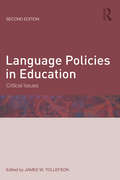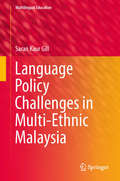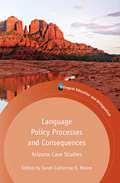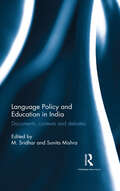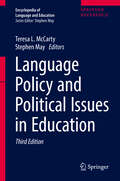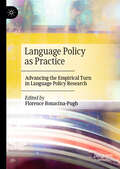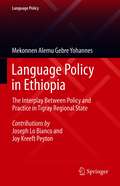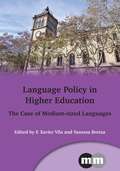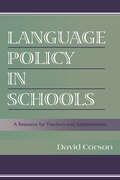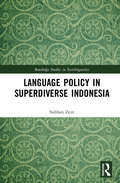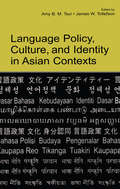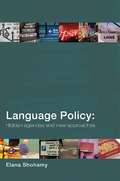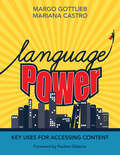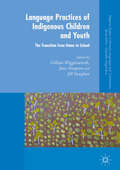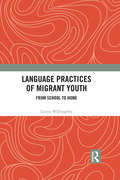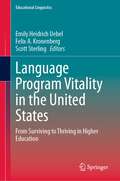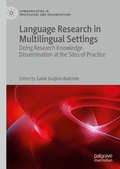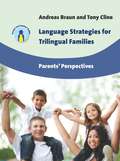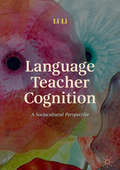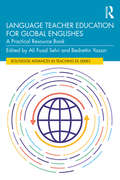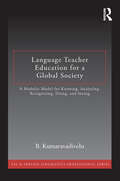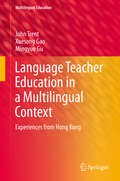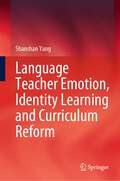- Table View
- List View
Language Policies in Education: Critical Issues
by James W. TollefsonHow do language policies in schools create inequalities among learners? How do policies marginalize some students while granting privilege to others? How do language policies in education serve the interests of dominant groups within societies? How can linguistic minorities further their interests through attempts to change language policies in schools? This new edition of Language Policies in Education takes a fresh look at these enduring questions at the heart of fundamental debates about the role of schools in society, the links between education and employment, and conflicts between linguistic minorities and "mainstream" populations. Reflecting developments in language policy since the publication of the first edition in 2002, all chapters are original and substantial contributions to the study of language policy and exemplify major theories and research methods in the field. Chapter authors are major scholars in language policy and critical language studies. The case studies, international in scope, present cutting-edge analyses of important language policy debates in countries around the world.
Language Policy Challenges in Multi-Ethnic Malaysia
by Saran Kaur GillSet in Malaysia, this book encompasses language and cultural policy challenges that many other multi-ethnic nations currently have to address. The people of Malaysia constitute a diverse ethnic, linguistic and cultural population and one of the continuing challenges is the development and establishment of the Malaysian people's ethnic, national and global cultural identities. This challenge is evident in the journey of language and cultural policy from the post-independence period to the 21st century; a period of over 50 years. The book highlights political, socio-cultural, economic and knowledge economy factors as they impact on decisions made by the government with regard to language policy in the various educational systems. It examines decisions made on the selection of the national language, the medium of instruction in educational systems, the varying changes in language policy for the field of science and technology and the maintenance and sustenance of minority languages.
Language Policy Processes and Consequences
by Sarah Catherine K. MooreThis book accessibly and comprehensively outlines the highly complex case of the English-only movement and educational language policy in Arizona. It ranges from early Proposition 203 implementation to an investigation of what Structured English Immersion (SEI) policy looks like in today's classrooms, and concludes with a discussion on what the various cases mean for the education of English learners in the state.
Language Policy and Education in India: Documents, contexts and debates
by M. Sridhar Sunita MishraThis book presents a history of English and development of language education in modern India. It explores the role of language in colonial attempts to establish hegemony, the play of power, and the anxieties in the nineteenth- and early-twentieth-century India. The essays in the volume discuss language policy, debates and pedagogy as well as larger overarching questions such as identity, nationhood and sub-nationhood. The work also looks at the socio-cultural and economic factors that shaped the writing and publishing of textbooks, dictionaries and determined the direction of language teaching, specifically, of English language teaching. Drawing on a variety of archival sources — policy documents, books, periodicals — this book will be of great interest to scholars and researchers of linguistics, language teaching, cultural studies and modern Indian history.
Language Policy and Political Issues in Education
by Teresa L. Mccarty Stephen MayLanguage has too often been studied in isolation from the social and political conditions in which it is used. The late David Corson, the General Editor of the first edition of the Encyclopedia of Language and Education, held the position that an acute understanding of theory was a necessary prerequisite for action, not an alternative to it, especially if one were hoping to change policies for the better. The contributions in this volume acknowledge the centrality of the politics of language, highlighting the importance of the social and political contexts of language policy and language education. This is one of ten volumes of the Encyclopedia of Language and Education. The Encyclopedia bears testimony to the dynamism and evolution of the language and education field, as it confronts the ever-burgeoning and irrepressible linguistic diversity and ongoing pressures and expectations placed on education around the world.
Language Policy as Practice: Advancing the Empirical Turn in Language Policy Research
by Florence Bonacina-PughThis edited book brings together original contributions from scholars working across Language Policy and Planning to advance the recent 'Empirical turn' that has taken place in the field. All the chapters in the volume show how Language Policy can be conceptualized 'as practice' in a variety of domains, ranging from the home to the workplace, schools, and higher education. The authors also suggest further theoretical, methodological, and empirical developments for the discipline in light of this epistemological shift. A Foreword and an Afterword shed light on the theoretical and empirical lineage of this volume and show how this book contributes to the humanization of Language Policy research. This book will be of interest to scholars and post-graduate students working across Language Policy and Planning, Language in Education Policy, and Family Language Policy, as well as those in adjacent fields including Education Policy, Classroom Discourse, Linguistic Anthropology, Sociologyof Education, and Multilingualism.
Language Policy at the Supranational Level: English and the ASEAN (Language Policy #37)
by Ian Hardy M. Obaidul Hamid Huan Yik LeeThis book provides a critical examination of the English-only policy of ASEAN, the Association of the ten Southeast Asian nations. It presents the ASEAN language policy and planning (LPP) journey through time: rationalising English as the sole working language for ASEAN in the past, followed by a critique of the status quo considering regional complexities and dynamics, and finally exploring alternative linguistic futures for ASEAN and the Southeast Asian region. The book also offers methodological innovations in LPP research by utilising the largely underrepresented and undervalued agency of 'people with expertise'. The authors argue for a multilingual commitment towards pursuing an agency of 'projectivity' in co-constructing imagined LPP possibilities to reflect the region's socio-historical context, socio-political intricacies, and socio-linguistic diversity. The way forward is a more inclusive, equitable, balanced, and responsible approach to LPP, both regionally and globally. The book engages with both deconstructive and constructive paradigms, offering promising proposals for dealing with key language issues and contemporary challenges. This book will be interesting reading for language and education scholars, sociolinguists, historians, political scientists, policymakers, diplomats, language activists, media personnel, business leaders, tourism players and other language policy and planning actors operating at national, sub-national and supra-national levels.
Language Policy in Ethiopia: The Interplay Between Policy and Practice in Tigray Regional State (Language Policy #24)
by Mekonnen Alemu YohannesThis book examines the interplay and tensions between hegemonic and counter-hegemonic language policy and processes in Tigray, a regional state of Ethiopia, in the period of pre- and post-1991. Viewing language use and language policy as dynamic social and ideological processes, the book presents Ethiopia as an example of language policy creation and implementation over time, in a highly volatile political context. The case of Ethiopia is unique in that different language policies and practices were put in place as the country’s leaders changed through political takeovers. Declared language policies were not always implemented, and those implemented were often protested. The book starts with an overview and review of language policy and planning, followed by a chapter on the history of such planning in Ethiopia. It then presents the methodology used for the study, and examines the appropriation of hegemonic LPP, patterns of resistance, schools and public sites as centers of resistance, and the emergence and development of specific patterns of language use in different regions of the country. The book ends with recommendations for future research, and draws the overall conclusion that since LPP is a dynamic and multilayered contextual process, official or de facto language policy is often undermined by overt or covert unofficial language policies, ideologies, mechanisms, and agents that result in different patterns of language use.
Language Policy in Higher Education
by F. Xavier Vila Vanessa BretxaIn today's increasingly interconnected, knowledge-based world, language policy in higher education is rapidly becoming a crucial area for all societies aiming to play a part in the global economy. The challenge is double faceted: how can universities retain their crucial role of creating the intellectual elites who are indispensable for the running of national affairs and, at the same time, prepare their best-educated citizens for competition in a global market? To what extent is English really pushing other languages out of the academic environment? Drawing on the experience of several medium-sized language communities, this volume provides the reader with some important insights into how language policies can be successfully implemented. The different sociolinguistic contexts under scrutiny offer an invaluable comparative standpoint to understand what position can - or could - be occupied by each language at the level of higher education.
Language Policy in Schools: A Resource for Teachers and Administrators
by David CorsonLanguage Policy in Schools provides school administrators and teachers a practical approach for designing a language policy for their school and for dealing with the language issues that confront schools, particularly those operating in settings of linguistic and cultural diversity. It can be used as a text in teacher and administrator preparation programs, graduate programs, and in-service and professional development programs. Special features include: * a clear, jargon-free writing style that invites careful reading; * abundant examples that students of education everywhere can learn from--including samples of school language policies developed for real schools by real teacher-researchers; * questions at the end of each chapter to highlight key points and stimulate informed discussion among pre-service and experienced teachers and administrators; and * an up-to-date international and cross-cultural biography.
Language Policy in Superdiverse Indonesia (Routledge Studies in Sociolinguistics)
by Subhan ZeinIndonesia has an extreme diversity of linguistic wealth, with 707 languages by one count, or 731 languages and more than 1,100 dialects in another estimate, spoken by more than 600 ethnicities spread across 17,504 islands in the archipelago. Smaller, locally used indigenous languages jostle for survival alongside Indonesian, which is the national language, regional lingua francas, major indigenous languages, heritage languages, sign languages and world languages such as English, Arabic and Mandarin, not to mention emerging linguistic varieties and practices of language mixing. How does the government manage these languages in different domains such as education, the media, the workplace and the public while balancing concerns over language endangerment and the need for participation in the global community? Subhan Zein asserts that superdiversity is the key to understanding and assessing these intricate issues and their complicated, contested and innovative responses in the complex, dynamic and polycentric sociolinguistic landscape of Indonesia that he conceptualises as superglossia. This offers an opportunity for us to delve more deeply into such a context through the language and superdiversity perspective that is in ascendancy. Zein examines emerging themes that have been dominating language policy discourse including status, prestige, corpus, acquisition, cultivation, language shift and endangerment, revitalisation, linguistic genocide and imperialism, multilingual education, personnel policy, translanguaging, family language policy and global English. These topical areas are critically discussed in an integrated manner against Indonesia’s elaborate socio-cultural, political and religious backdrop as well as the implementation of regional autonomy. In doing so, Zein identifies strategies for language policy to help inform scholarship and policymaking while providing a frame of reference for the adoption of the superdiversity perspective on polity-specific language policy in other parts of the world.
Language Policy, Culture, and Identity in Asian Contexts
by Amy B. M. TsuiBringing together scholarship on issues relating to language, culture, and identity, with a special focus on Asian countries, this volume makes an important contribution in terms of analyzing and demonstrating how language is closely linked with crucial social, political, and economic forces, particularly the tensions between the demands of globalization and local identity. A particular feature is the inclusion of countries that have been under-represented in the research literature, such as Nepal, Bangladesh, Brunei Darussalam, Pakistan, Cambodia, Vietnam, and Korea. The book is organized in three sections: Globalization and its Impact on Language Policies, Culture, and Identity Language Policy and the Social (Re)construction of National Cultural Identity Language Policy and Language Politics: The Role of English. Unique in its attention to how the domination of English is being addressed in relation to cultural values and identity by non-English speaking countries in a range of sociopolitical contexts, this volume will help readers to understand the impact of globalization on non-English speaking countries, particularly developing countries, which differ significantly from contexts in the West in their cultural orientations and the way identities are being constructed. Language Policy, Culture, and Identity in Asian Contexts will interest scholars and research students in the areas of language policy, education, sociolinguistics, applied linguistics, and critical linguistics. It can be adopted in graduate and advanced undergraduate courses on language policy, language in society, and language education.
Language Policy: Hidden Agendas and New Approaches
by Elana ShohamyPolicies concerning language use are increasingly tested in an age of frequent migration and cultural synthesis. With conflicting factors and changing political climates influencing the policy-makers, Elana Shohamy considers the effects that these policies have on the real people involved. Using examples from the US and UK, she shows how language policies are promoted and imposed, overtly and covertly, across different countries and in different contexts. Concluding with arguments for a more democratic and open approach to language policy and planning, the final note is one of optimism, suggesting strategies for resistance to language attrition and ways to protect the linguistic rights of groups and individuals.
Language Power: Key Uses for Accessing Content
by Margo Gottlieb Mariana CastroHere, at last, is every K-8 teacher’s playbook on the critical role academic language plays in content learning and student achievement. What exactly is so different? Margo Gottlieb and Mariana Castro distill the complexities of language learning into four key uses through which students can probe the interplay between language and content, then demonstrate their knowledge and understanding. It’s as straight-forward as that.
Language Power: Key Uses for Accessing Content
by Margo Gottlieb Mariana CastroHere, at last, is every K-8 teacher’s playbook on the critical role academic language plays in content learning and student achievement. What exactly is so different? Margo Gottlieb and Mariana Castro distill the complexities of language learning into four key uses through which students can probe the interplay between language and content, then demonstrate their knowledge and understanding. It’s as straight-forward as that.
Language Practices of Indigenous Children and Youth
by Gillian Wigglesworth Jane Simpson Jill VaughanChildren all over the world are making the transition from home to school as they enter the formal education system. This volume explores the experiences of language minority children from the age of four, in Australia and around the world as they move from home language to mastering the dominant language of the country.
Language Practices of Migrant Youth: From School to Home
by Louisa WilloughbyThis ground breaking research explores language maintenance and shift focusing on a school community. Following students’ language practice inside and outside of school, the author offers a full picture of students’ multilingual practices and their role in shaping identity. Using case studies of eight girls from Vietnamese and Cambodian backgrounds, the book draws on data from questionnaires, interviews and ethnographic observation to bring these language practices to life. It explores the place of heritage languages, English and other languages in the girls’ repertoires and investigates the role they see for these languages in their lives. A key focus of the book is the role of the school environment in shaping students’ repertoires and unfolding sense of ethnic identity; both directly through formal instruction and indirectly through its ethos and social composition. It provides practical suggestions on the basis of extensive research for how schools can negotiate some of the challenges of catering to a multiethnic population. Essential reading for anyone researching migrant language practice, sociolinguistics or multicultural education.
Language Program Vitality in the United States: From Surviving to Thriving in Higher Education (Educational Linguistics #63)
by Scott Sterling Emily Heidrich Uebel Felix A. KronenbergThe perception of a permanent enrollment crisis in US postsecondary foreign language education has shaped our profession’s image for an entire generation of educators. Over the past 30 years, this crisis rarely invited self-examination or inspired creativity. Instead, it was routinely attributed to external factors: shrinking budgets, unsympathetic administrators, disengaged students. This volume is refreshingly optimistic: After providing a nuanced picture of the complex enrollment situation and focusing on perceptions of language education among undergraduate students, the volume features an inspiring panorama of successful models that revitalized language programs at a wide range of institutions. The diversity of approaches to post-secondary language education in the United States featured in this volume highlights that there are no simple “one size fits all” solutions. To be transformational, initiatives need to be intimately calibrated to the evolving needs and desires of our institutions’ most important stakeholder: the student. Per Urlaub, Massachusetts Institute of Technology, MA, USA
Language Research in Multilingual Settings: Doing Research Knowledge Dissemination at the Sites of Practice (Communicating in Professions and Organizations)
by Lubie Grujicic-AlatristeThis book describes the steps undertaken by language researchers to disseminate their findings at sites of practice. It discusses questions that arise from such efforts and provides meaningful, real-life, first-hand accounts of both interactions with practitioners and practitioners’ feedback. The authors use narrative accounts, case studies, and semi-ethnographies of focus groups and workshops to draw a full picture of dissemination, its intricacies, multiple stakeholder interests, reflexivity challenges, and future relevance and responsibility for all parties involved. It is an attempt to fill the gap between the end of research domains and the places of dissemination of research findings, and the book will be of interest to applied linguistics researchers, students and scholars of organisational discourse, and practitioners working in multilingual settings.
Language Strategies for Trilingual Families
by Andreas Braun Tony ClineThis book aims to enable parents in trilingual families to consider possible language strategies on the basis of analysing their individual circumstances. It includes a tool for diagnostic self-analysis that will help each reader to identify their situation and learn how parents in similar situations have approached the task of supporting their children's use of languages. Based on a unique survey of parents in trilingual families in two European countries, the book highlights the challenges that trilingual families face when living in mainly monolingual societies. It takes into account the recent emergence of a 'New Trilingualism' among educated parents who find themselves in trilingual families because of global trends in migration and the recent expansion of the EU.
Language Teacher Cognition: A Sociocultural Perspective
by Li LiThis book explores the topic of teacher cognition, making use of sociocultural theory as a framework to understand what teachers know, think, believe and do in their professional contexts through ‘applied’ conversation analysis. The author examines what teaching and learning mean to teachers by analyzing the interactional work they do with their students, considering when and why teachers make interactive decisions as well as how they utilize new technological tools to address their pedagogical objectives. After discussing how teachers construct identities and display emotions in the classroom, she presents suggestions for language teacher education and development, pedagogy improvement and teacher knowledge. This book will be of interest to language teachers and teacher trainers, as well as students and scholars of applied linguistics and sociocultural theory.
Language Teacher Education for Global Englishes: A Practical Resource Book (Routledge Advances in Teaching English as an International Language Series)
by Ali Fuad SelviThis practical resource book showcases both the theory and practical application for teacher educators in diverse contexts bringing a global Englishes perspective into their teacher education courses, both at pre- and in-service levels. The recent Global Englishes paradigm serves as a promising response to the complexity of identity, interaction, use, and instruction surrounding the English language. It is increasingly important to enhance teachers’ knowledge base—their specialized knowledge, skills, competencies, and commitments—vis-à-vis the changing needs of English Language Teaching. The chapters in the book provide accessible theoretical orientation to different aspects of the Global Englishes paradigm, from instructional materials to language assessment, and are complemented by a range of practical applications that promote teacher development. The volume is recommended as a viable professional development resource for teacher educators who are looking for activities and resources in preparing teachers for diverse teaching contexts, realities, affordances, and constraints.
Language Teacher Education for a Global Society: A Modular Model for Knowing, Analyzing, Recognizing, Doing, and Seeing (ESL & Applied Linguistics Professional Series)
by B. KumaravadiveluThe field of second/foreign language teacher education is calling out for a coherent and comprehensive framework for teacher preparation in these times of accelerating economic, cultural, and educational globalization. Responding to this call, this book introduces a state-of-the-art model for developing prospective and practicing teachers into strategic thinkers, exploratory researchers, and transformative teachers. The model includes five modules: Knowing, Analyzing, Recognizing, Doing, and Seeing (KARDS). Its goal is to help teachers understand: how to build a viable professional, personal and procedural knowledge-base, how to analyze learner needs, motivation and autonomy, how to recognize their own identities, beliefs and values, how to do teaching, theorizing and dialogizing, and how to see their own teaching acts from learner, teacher, and observer perspectives. Providing a scaffold for building a holistic understanding of what happens in the language classroom, this model eventually enables teachers to theorize what they practice and practice what they theorize. With its strong scholarly foundation and its supporting reflective tasks and exploratory projects, this book is immensely useful for students, practicing teachers, teacher educators, and educational researchers who are interested in exploring the complexity of language teacher education.
Language Teacher Education in a Multilingual Context
by John Trent Xuesong Gao Mingyue GuThis book provides a multifaceted, multilayered examination of the processes and challenges language teachers face in constructing their professional identities in multilingual contexts such as Hong Kong. It focuses on how professional and personal identities are enacted as individuals cross geographic, educational, and socio-cultural boundaries to become English language teachers in Hong Kong. It explores the construction of language teachers' professional identities from multiple perspectives in multiple settings, including pre-service and in-service teachers from Hong Kong, Mainland China, and Western countries. Understanding the difficulties and challenges these language teachers face in their identity and professional development is of relevance to teachers and teacher educators, as well as those interested in becoming language teachers in multilingual contexts.
Language Teacher Emotion, Identity Learning and Curriculum Reform
by Shanshan YangThis book explores language teachers' identity learning through the lens of teacher emotions. This qualitative study, utilizing a longitudinal case study design, sets out to trace how four college English teachers at the case study university in East China respond emotionally towards the curriculum reform, how teacher identity learning takes place, and how emotions interact with the identity learning processes. Guided by the theoretical framework, this book adopts diversified methods to collect data across one academic year of curriculum implementation. It also discusses the findings which reveal that curriculum reform poses great emotional challenges for English as a Foreign Language (EFL) teachers, teachers who traverse across emotional geographies, orient to feeling rules, and perhaps translate emotion work into emotional capital. This book explores language teachers' identity learning.This book helps the researchers, policymakers, and other stakeholders involved in higher education policymaking to understand how EFL teacher emotions can be utilized to support EFL teachers' identity learning and thus sustain curriculum reform efforts.
